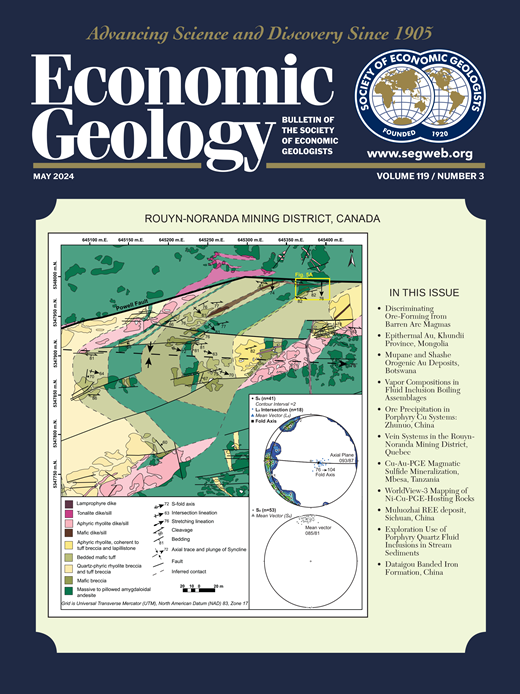Fe-As-S体系——相位关系及其应用
IF 4.9
1区 地球科学
Q1 GEOCHEMISTRY & GEOPHYSICS
引用次数: 151
摘要
通过系统地收集Fe-As-S合成系统的物理和化学数据,为解释矿石中Fe-As-S矿物组合提供了基础。最有趣的是通常观察到的矿物对黄铁矿-毒砂共存的温度限制在491℃。毒砂和/或钙辉石中的砷硫比可能为目前可用于矿石研究的一组地热测量技术增加了一项新技术。在600℃以上的温度和2070 bar的围压下,Au在细粒毒砂中迅速扩散,这一观察结果为许多矿石中Au和毒砂的关系提供了一些见解。在600℃时测定了Fe-As-S体系的平衡相关系,在400 ~ 800℃温度范围内研究了组合的变化。在600摄氏度时,沿着三元体系的As-S侧有一个非常窄的液场,在100到22.8±0.2重量% s之间,系线将这个液场的各个部分与黄铁矿、磁黄铁矿和毒砂连接起来。在此温度下,磁黄铁矿-毒砂、毒黄铁矿-砷、毒黄铁矿-铁辉石、磁黄铁矿-铁辉石、磁黄铁矿-铁辉石、铁辉石-铁辉石之间也存在联系线。在600℃以上的温度下,合成毒砂的成分近似为FeAs (sub 1.1) S (sub 0.9)。相对于理想FeAsS富S的组分在较低温度和高围压下变得稳定。不同温度下相组合的变化受黄铁矿+毒砂磁黄铁矿+液体或蒸汽、毒砂+砷黄铅矿+液体或蒸汽、毒砂磁黄铁矿+骆铅矿+液体或蒸汽等反应的支配。在这些组合中存在液体和蒸汽的恒定温度为491°C +或- 12°C, 688°C +或- 3°C, 702°C +或- 3DGC。,分别。第一个反应是在高达2070巴的围压下进行的,在这个压力下,黄铁矿和毒砂可以共存,最高可达528摄氏度+或- 10摄氏度。本文章由计算机程序翻译,如有差异,请以英文原文为准。
The Fe-As-S system--Phase relations and applications
A basis for the interpretation of Fe-As-S mineral assemblages in ores has been provided through systematic collection of physical and chemical data in the synthetic system Fe-As-S. Most interesting is the temperature limitation of 491 degrees C. for coexistence of the commonly observed mineral pair pyrite-arsenopyrite. The As:S ratio in arsenopyrite and/or loellingite may add another to the group of geothermometry techniques now available for ore studies. The observation that Au diffuses rapidly through fine-grained arsenopyrite at temperatures above 600 degrees C. and confining pressures up to 2,070 bars provides some insight into the relations of Au and arsenopyrite in many ores. Equilibrium phase relations in the Fe-As-S system were determined at 600 degrees C., and changes in assemblages were studied in the 400 degrees to 800 degrees C. temperature range. At 600 degrees C. a very narrow liquid field lies along the As-S side of the ternary system between 100 and 22.8 + or - 0.2 weight percent S. Tie-lines connect various parts of this liquid field to pyrite, to pyrrhotite, and to arsenopyrite. At this temperature there are also tie-lines between pyrrhotite-arsenopyrite, arsenopyrite-As, arsenopyrite-toellingite, pyrrhotite-loellingite, pyrrhotite-FeAs, and FeS-Fe 2 As. At temperatures above 600 degrees C. synthetic arsenopyrite has the approximate composition FeAs (sub 1.1) S (sub 0.9) . Compositions that are S rich relative to ideal FeAsS become stable at lower temperatures and under high confining pressures. Changes in the phase assemblages at various temperatures are governed by the reactions: pyrite + arsenopyrite pyrrhotite + liquid or vapor, arsenopyrite + As loellingite + liquid or vapor, and arsenopyrite pyrrhotite + loellingite + liquid or vapor. The invariant temperature at which both liquid and vapor are present in these assemblages are 491 degrees + or - 12 degrees C., 688 degrees + or - 3 degrees C., and 702 degrees + or - 3DGC., respectively. The first reaction was investigated at confining pressures up to 2,070 bars, at which pressure pyrite and arsenopyrite can coexist up to 528 degrees + or - 10 degrees C.
求助全文
通过发布文献求助,成功后即可免费获取论文全文。
去求助
来源期刊

Economic Geology
地学-地球化学与地球物理
CiteScore
10.00
自引率
6.90%
发文量
120
审稿时长
6 months
期刊介绍:
The journal, now published semi-quarterly, was first published in 1905 by the Economic Geology Publishing Company (PUBCO), a not-for-profit company established for the purpose of publishing a periodical devoted to economic geology. On the founding of SEG in 1920, a cooperative arrangement between PUBCO and SEG made the journal the official organ of the Society, and PUBCO agreed to carry the Society''s name on the front cover under the heading "Bulletin of the Society of Economic Geologists". PUBCO and SEG continued to operate as cooperating but separate entities until 2001, when the Board of Directors of PUBCO and the Council of SEG, by unanimous consent, approved a formal agreement of merger. The former activities of the PUBCO Board of Directors are now carried out by a Publications Board, a new self-governing unit within SEG.
 求助内容:
求助内容: 应助结果提醒方式:
应助结果提醒方式:


